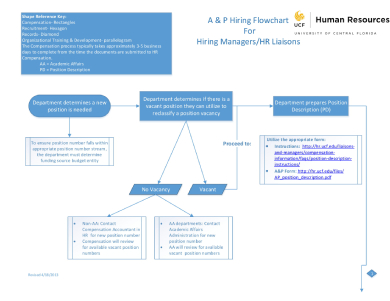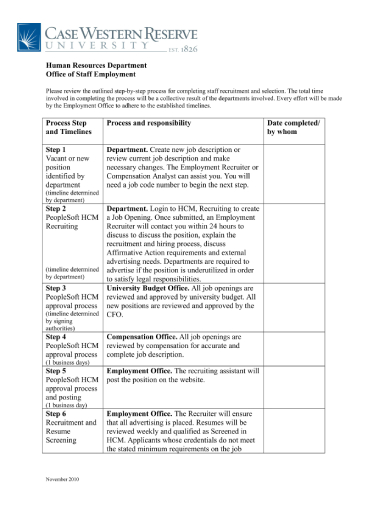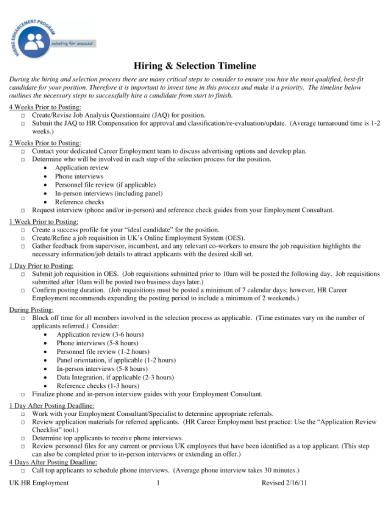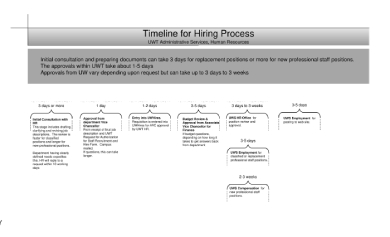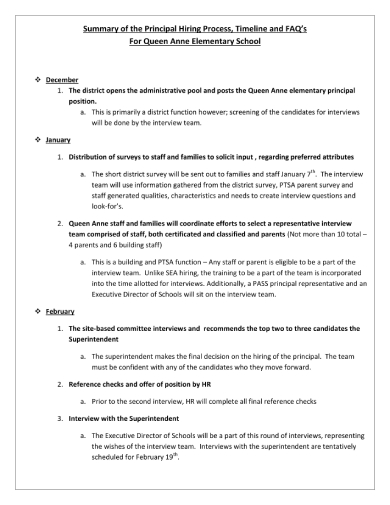Companies would always make sure to perform their recruitment procedures without any lapses and mistakes. One strategic tool they use are process timelines. This tool is a flow diagram that creates a visual presentation of the written procedures for the recruitment system, making the processes easier to understand and read. If you are new to the industry, you can read further in this article to learn more about this type of HR document.
What Is a Recruitment Process Timeline?
A process timeline is a document that helps a company plan their recruitment system accordingly. This HR document comes in either charts or checklists that allow HR employees to input details easily. Using process timelines will help the recruiters’ carry out the procedures without a hassle. A recruitment process timeline usually contains each of the system’s processes, estimated time of execution, and the person-in-charge. It also reflects a brief description of the process so the employees could understand the recruitment process efficiently.
FREE 6+ Recruitment Process Timeline Samples in PDF
1. HR Recruitment Process Timeline
2. HR Hiring Process Timelines
3. Flowchart for Hiring Process Timelines
4. Recruitment Process Timeline Sample
5. Timeline for Hiring Process
6. Recruiting Timeline Sample
7. Hiring/Recruitment Process Timeline
Benefits of Using Recruitment Process Timeline
Creating process timelines is common in performing a business’ recruitment procedures. This diagram allows HR recruiters to review, manage, and track their operations smoothly. Companies always aim for a successful recruitment procedure to attract more job applicants to work with them. That is why process timelines are there to remind recruiters of the methods they are going to execute. There are more advantages for using process timelines in your operations. To enlighten you, here are some of its benefits in a company.
Allows you to keep track of the operations: Just like flow diagrams and other charts, the process timeline will allow you to track on every process of the recruitment system. This business flowchart provides you the allotted schedule about the activities you are going to perform for the recruitment process. It also informs you of the next process you are going to do and where the operation takes place.
Helps you meet deadlines: Process timelines remind you of the deadlines of each process you have to perform for the recruitment process. The diagram will help your recruiting team meet deadlines and maintain the pace you have set for the job application process. It is also easy to remember since it is a visual presentation of your operations, leading you to a smooth employment procedure.
Keeps every process organized: As a recruiter, you must make sure your hiring processes are performing as planned. With the help of a process timeline, you will have a steady workflow as you complete your recruitment process. The chart will surely guide you since it provides you precise information about the recruitment management system.
Guides new HR recruiters: Your timelines will serve as infographics about your recruitment system. As said earlier, the process timelines are easy to remember since it is a flow diagram. According to a study about visual learning style, people often remember images or charts than text documents. Process timelines are excellent tools in training and maintaining the quality performance of operations.
How to Create a Recruitment Process Timeline
Process timelines are always part of a business plan. Companies always aim to create a process timeline accurately so their operations would be carried out without any errors. This chart allows the recruiters to input details—such as schedules, process descriptions, and many more—that makes their procedures more organized. If you are not familiar with making timelines, you can use the following steps and tips to guide you.
Step 1: Know the Recruitment System
The first thing you need to do is to be familiar with the recruitment process. The timeline will need an accurate process description, allotted schedule, and the person-in-charge for the operation. Every company has different ways on how to manage their hiring processes—it has to match with the company’s quality policy. You should review everything in the company’s operational manual so you can come up with a useful recruitment timeline for the whole HR employees or recruiters.
Step 2: Outline the Process’ Information
Once you have reviewed the recruitment system, you need to outline the entire recruitment process to prepare the timeline. Most employees create their process outlines as a recruitment checklist so they can quickly fill in the process timeline later on. Make sure you have prepared accurate information to avoid any misunderstandings and conflicts while using the final process timeline.
Step 3: Decide on a Timeline Format
A recruitment process timeline can come in different formats. Gantt charts are the most common format companies use. Other companies use their recruitment flow charts as their process timeline. The difference is that flow charts only visualize the recruitment process while the recruitment timeline involves the scheduling of each of the procedures. This strategy will help the recruiters manage their time and keep their operations smooth. If you want suggestions, you can use some sample process timelines available online to have reference documents.
Step 4: Fill in the Essential Details
After finalizing the timeline format, you can proceed to fill in the essential information—the process description, the schedule, and the person-in-charge. There are other details you can add to make your timelines readable and understandable. You can insert legends or other indicators to guide the employees in using the recruitment process timeline. Just like other documents, you must proofread the process schedule to prevent any errors while carrying out the operation.
Step 5: Keep it Up-to-Date
Just like checklists, your timelines need to be updated so you can monitor the recruitment operations regularly. Keeping your process timelines updated will also aid you in identifying lapses and errors in the system. If you or the recruiters have spotted a mistake, you can fix it immediately before it escalates and affects the operations even more.
Related Posts
-
FREE 7+ Recruitment Flow Chart Samples in PDF
-
FREE 7+ Recruitment Checklist Samples in PDF
-
FREE 6+ Accident Investigation Form Samples in PDF | MS Word
-
FREE 45+ Work From Home Forms in PDF | MS Word
-
FREE 23+ Employee Leave Request Forms in PDF | MS Word | XLS
-
FREE 53+ Human Resources Forms in PDF | MS Word | Excel
-
FREE 5+ Recruiter Performance Review Forms in PDF | MS Word
-
FREE 7+ Payroll Adjustment Forms in MS Word | PDF | Excel
-
FREE 3+ HR Employee Concern Forms in PDF
-
FREE 6+ Telephone Reference Check Forms in PDF | MS Word
-
FREE 3+ Consultant Bio-Data Forms in PDF | MS Word
-
FREE 7+ Compensation and Benefits Forms in PDF
-
FREE 10+ Reduced Fee Enrollment Application Forms in PDF | MS Word
-
FREE 10+ Name Address Change Forms in PDF | MS Word
-
FREE 11+ Confidential Evaluation Forms in PDF | MS Word

